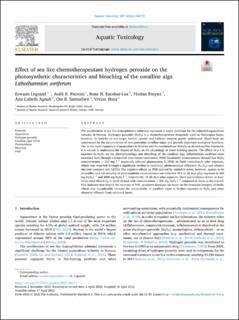| dc.contributor.author | Legrand, Erwann | |
| dc.contributor.author | Parsons, Aoife Elizabeth | |
| dc.contributor.author | Escobar, Rosa | |
| dc.contributor.author | Freytet, Florian | |
| dc.contributor.author | Agnalt, Ann-Lisbeth | |
| dc.contributor.author | Samuelsen, Ole Bent | |
| dc.contributor.author | Husa, Vivian | |
| dc.date.accessioned | 2022-11-03T09:44:14Z | |
| dc.date.available | 2022-11-03T09:44:14Z | |
| dc.date.created | 2022-10-11T13:46:23Z | |
| dc.date.issued | 2022 | |
| dc.identifier.citation | Aquatic Toxicology. 2022, 247 . | en_US |
| dc.identifier.issn | 0166-445X | |
| dc.identifier.uri | https://hdl.handle.net/11250/3029788 | |
| dc.description.abstract | The proliferation of sea lice (Lepeophtheirus salmonis) represents a major challenge for the salmonid aquaculture industry in Norway. Hydrogen peroxide (H2O2) is a chemotherapeutant frequently used on Norwegian farms, however, its toxicity to non-target benthic species and habitats remains poorly understood. Maerl beds are constructed by the accumulation of non-geniculate coralline algae and provide important ecological functions. Due to the rapid expansion of aquaculture in Norway and the continued use of H2O2 as an anti-sea lice treatment, it is crucial to understand the impact of H2O2 on the physiology of maerl-forming species. The effects of a 1 h exposure to H2O2 on the photophysiology and bleaching of the coralline alga Lithothamnion soriferum were examined here through a controlled time-course experiment. PAM fluorimetry measurements showed that H2O2 concentrations ≥ 200 mg l−1 negatively affected photosystem II (PSII) in thalli immediately after exposure, which was observed through a significant decline in maximum photochemical efficiency (Fv/Fm) and relative electron transport rate (rETR). The negative effects on PSII induced by oxidative stress, however, appear to be reversible, and full recovery of photosynthetic characteristics was observed 48 h to 28 days after exposure to 200 mg H2O2 l−1 and 2000 mg H2O2 l−1, respectively. At 28 days after exposure, there was evidence of two- to four-times more bleaching in thalli treated with concentrations ≥ 200 mg H2O2 l−1 compared to those in the control. This indicates that despite the recovery of PSII, persistent damages can occur on the structural integrity of thalli, which may considerably increase the vulnerability of coralline algae to further exposure to H2O2 and other chemical effluents from salmonid farms. | en_US |
| dc.language.iso | eng | en_US |
| dc.title | Effect of sea lice chemotherapeutant hydrogen peroxide on the photosynthetic characteristics and bleaching of the coralline alga Lithothamnion soriferum | en_US |
| dc.title.alternative | Effect of sea lice chemotherapeutant hydrogen peroxide on the photosynthetic characteristics and bleaching of the coralline alga Lithothamnion soriferum | en_US |
| dc.type | Peer reviewed | en_US |
| dc.type | Journal article | en_US |
| dc.description.version | publishedVersion | en_US |
| dc.source.pagenumber | 10 | en_US |
| dc.source.volume | 247 | en_US |
| dc.source.journal | Aquatic Toxicology | en_US |
| dc.identifier.doi | 10.1016/j.aquatox.2022.106173 | |
| dc.identifier.cristin | 2060499 | |
| dc.relation.project | Havforskningsinstituttet: 14900 | en_US |
| cristin.ispublished | true | |
| cristin.fulltext | original | |
| cristin.qualitycode | 2 | |
